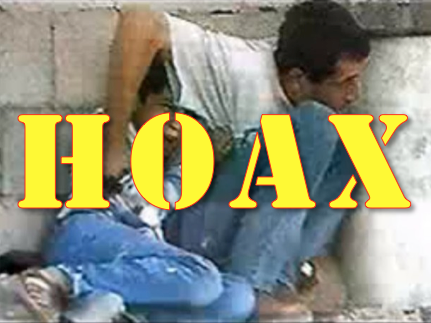The Israeli Government has released a comprehensive report into the infamous Al-Dura incident of Sep. 30, 2000, declaring that the 12-year-old Palestinian boy was not killed by Israeli soldiers and that journalists had perpetrated a “misleading and mendacious” hoax that had inspired terrorist violence against Jews and Israel.
The “Kuperwasser Report” (below) is the result of years of tireless research and argument by independent media activists such as France’s Philippe Karsenty, who has fought the state-owned France 2 channel, the original source of the Al-Dura story, in court for several years. Israel originally accepted the account as true.
The report provides extensive, detailed evidence refuting the claim that Muhammad Al-Dura was killed as he crouched with his father behind a barrel–including forensic analysis, glaring discrepancies in the statements of the sole witness, and the fact that Palestinian cameramen had been staging fake Israeli “attacks” at the site.
It also details the way in which the Al-Dura story became a “blood libel” that motivated Palestinian suicide bombers, as well as the murderers of Wall Street Journal journalist Daniel Pearl and the international campaign to label Israel an “apartheid” state, starting with the UN’s Durban racism conference in 2001.
The Al-Dura story was relayed around the world by the international media, and treated as verifiable fact by international human rights organizations, including Amnesty International and Human Rights Watch. Some journalists and activists have reportedly mocked the Kuperwasser Report as evidence of the Israel “lobby.”
Yet the evidence presented in the report is not only credible, but overwhelming. It draws sharp conclusions about the conduct of journalists in “asymmetric” conflicts involving terrorists or insurgents, noting that journalists often allow themselves, carelessly or willingly, to be manipulated by the supposedly “weaker” side:
When journalists acting under the pressures of the news cycle and the lure of a scoop fail to properly take account of this asymmetry, systematic distortion can occur. The militarily less-powerful side is able to successfully manipulate media coverage through the rapid dissemination of one-sided or false information, misleading images, and fabricated or even staged events….Given these factors, journalists must take the utmost precautions to maintain standards of objectivity and accuracy in presenting their information, claims and visuals.
The report goes on to cite the numerous ways in which the media’s coverage of the Al-Dura incident violated many of the profession’s own ethical rules and guidelines–the first of which is to seek the truth. It notes that France 2 in particular failed to investigate the claims of its “stringer” cameraman, and noted that the reporter who narrated the story, Charles Enderlin, had selectively edited out evidence that the boy was actually alive.
While the target in this case was the Israeli military, the Kuperwasser report notes that Western media in general face similar challenges when dealing with local correspondents working in undemocratic societies: “non-democratic states and non-state actors often posses an advantage over democracies due to their willingness to rapidly release statements without verifying or being held accountable for their accuracy.”
The report does not prescribe any new rules or standards for the media–merely that journalists live up to their own principles. It does, however, contain a new recommendation for the Israeli government and free governments worldwide: that inflammatory claims be investigated immediately, and the findings made public.
In 2000, Israel was not prepared to do that. Finally, it is prepared to face up to the media’s challenge.

COMMENTS
Please let us know if you're having issues with commenting.